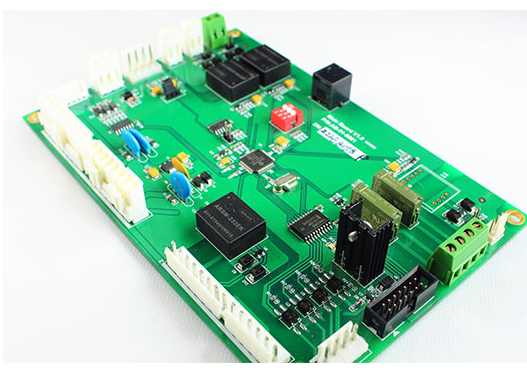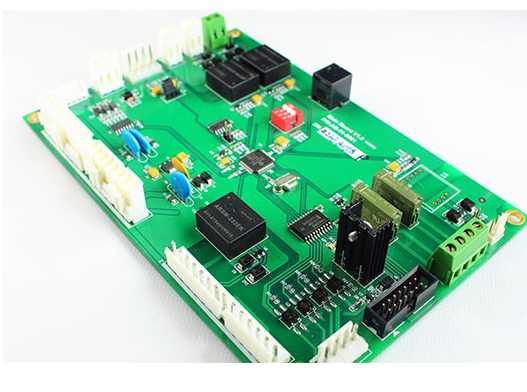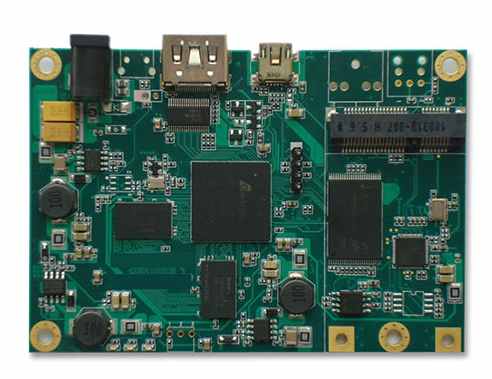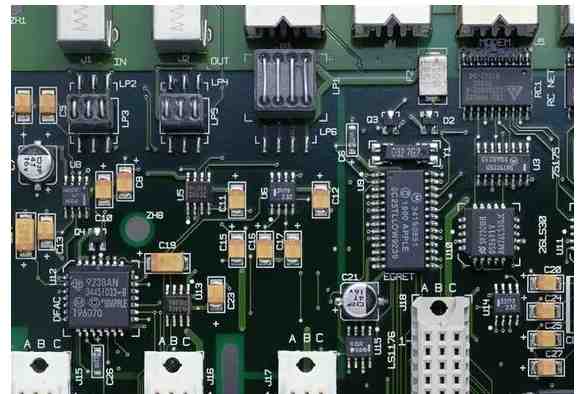
PCB PCBA processing process can be roughly divided into: empty board loading -> Printing solder paste -> Mount devices -> Reflow welding -> AOI testing -> Take-up plate -> Finished item inspection -> Parts after welding -> Circuit board open/Short Circuit Test -> Circuit board function -> Test cutting board.
1. Load the empty board
The first step in the assembly of the circuit board is to arrange the empty board neatly, and then put it on the material rack, and the machine will automatically send the board into the SMT production line one by one.
2. Print solder paste

The first step for the printed circuit board to enter the SMT production line is to print the solder paste, which is really a bit like a girl applying a mask on her face, here the solder paste will be printed on the welding pad of the PCB to be welded, and the solder paste will melt and weld the electronic parts on the circuit board when it passes through the high-temperature back welding furnace.
In addition, when the new product is tested, some people will use the adhesive film board/adhesive paper board to replace the solder paste, which can increase the efficiency and waste of the SMT adjustment machine.
3. Solder paste inspection machine
Because the solder paste printing is related to the welding quality of the following parts, some SMT factories in order to obtain stable quality, will first use optical instruments to check the solder paste printing quality after the solder paste printing, if there is a poor printing board will be hit, wash the solder paste above in the re-printing, or use the repair method to remove the excess solder paste.
4. Fast printing machine
Here, some small electronic parts (such as small resistors, capacitors, inductors) will be hit on the circuit board, these parts will be slightly stuck by the solder paste just printed on the circuit board, so even if the speed is very fast, fast to almost like a machine gun, the parts above the board will not fly away, but large parts are not suitable for use in the fast machine. One will drag down the speed of the small parts that were originally played very fast, and the other is afraid that the parts will offset the original position because the board will move quickly.
5. Universal type printing machine
Also known as "slow machine", here will be playing some relatively large electronic parts, such as BGA IC, connector... These parts need to be more accurate position, so the alignment is very important, before the piece will first use the camera to confirm the position of the parts, so the speed is much slower. Because of the size of the parts here, they do not necessarily have roll packaging, and some may be pallets or tubular packaging. However, if the SMT machine can eat pallets or tubular packaging materials, an additional machine must be configured.
Generally, the traditional punching/attaching machine uses the principle of suction to move electronic parts, so the top of these electronic parts must have a plane for the suction nozzle of the punching machine to absorb parts, but some electronic parts are unable to have a plane for these machines, at this time, it is necessary to order special suction nozzle for these special-shaped parts. Or put a flat layer of tape on the part, or wear a flat cap.
6. Hand swing parts or visual inspection
When all the parts are printed on the circuit board to be returned to the welding furnace at high temperature, a checkpoint is usually set up to pick out the offset or missing parts. The shortcomings, etc., because after the high temperature furnace, if there is still a problem, you must move the soldering iron, which will affect the quality of the product, and there will be additional costs; Other large electronic parts or traditional parts of DIP/THD or parts that cannot be operated by the printing/attaching machine for some special reasons will also be manually swung here.
In addition, some SMT of the mobile phone plate will also design an AOI before the backwelding furnace to confirm the quality before the backwelding, sometimes because the part will be marked with a shield frame, which will cause the AOI can not be used to check the solderability after the backwelding furnace.
7. Backweld
The purpose of backwelding is to melt the solder paste and form a non-metallic compound on the parts foot and circuit board, that is, welding electronic parts on the circuit board, the curve of the temperature rise and fall often affects the quality of the entire circuit board welding, according to the characteristics of the solder, the general backwelding furnace will be set preheating zone, infiltration zone, backwelding zone, cooling zone to achieve the best soldering effect. With the current lead-free SAC305 solder paste, its melting point is about 217 ° C, that is, the temperature of the backwelding furnace must be at least higher than this temperature to re-melt the solder paste, in addition, the maximum temperature in the backwelding furnace is best not to exceed 250 ° C, otherwise there will be many parts because there is no way to withstand such a high temperature and deformation or melting.
Basically, after the circuit board is welded back to the furnace, the assembly of the entire circuit board is completed, if there are hand welding parts exception, the rest is to check and test the circuit board has no defects or poor function.
8. Optical inspection of solderability
Not necessarily every SMT production line has an optical inspection machine (AOI), the purpose of setting AOI is because some circuit boards with too high density can not carry out subsequent on-off electronic testing (ICT), so AOI is replaced, but because AOI has its blind spot for optical interpretation, such as the solder under the parts can not be judged. At present, it is only possible to check whether the parts have tombstones or side stands, missing parts, displacement, polarity direction, tin bridge, air welding, etc., but it is not possible to judge the quality of parts such as fake welding, BGA weldability, resistance value, capacitance value, inductance value, so far, it is not possible to completely replace ICT.
Therefore, if only AOI is used to replace ICT, there is still some risk in quality, but ICT is not 100%, can only say that each other compensate for the test coverage rate, hope to achieve 100%, so you have to make a choice.
9. Reboard
After the boards are assembled, they are returned to the racks, which have been designed to allow the SMT machine to automatically remove and place the boards without compromising their quality.
10. Finished item inspection
Regardless of whether there is an AOI station, the general SMT line will still set up a visual inspection area of the circuit board, in order to check whether there is any bad after the assembly of the circuit board, if there is an AOI station, the number of visual inspection personnel can be reduced, because it is still necessary to check some places that AOI can not be interpreted, or check the bad AOI.
Many factories will provide visual inspection templates at this station to facilitate the inspection of some key parts and parts polarity.
11. Parts after welding
If some parts cannot be printed with SMT, a touch-up (post-process repair) hand welding of the part is required, which is usually placed after the finished product inspection to distinguish whether the defect is from SMT or the subsequent process.
After welding parts to use the soldering iron and tin wire, welding will be maintained at a high temperature of the soldering iron contact the part foot to solder, until the temperature rises enough to melt the tin wire temperature, and then add the tin wire melting, after the tin wire cooling will weld the parts on the circuit board.
Hand welding parts will have some smoke, these smoke will contain a lot of heavy metals, so the operation area must be set up smoke discharge equipment, try not to let the operator inhale these harmful fumes. It needs to be reminded that some parts will be arranged in a later stage of the process due to the needs of the process.
12. Circuit board open/short circuit test
Circuit board open/short Circuit Test (ICT, In-Circuit test) The purpose of ICT Settings is mainly to test whether the parts and circuits on the circuit board are open and short, and it can also measure the basic characteristics of most parts, such as resistance, capacitance, inductance value, and so on. To judge whether the function of these parts is damaged, wrong parts, missing parts after high temperature back welding furnace... Let's wait.
The circuit testing machine is divided into advanced and primary machines. The primary testing machine is generally referred to as the Manufacturing Defect Analyzer (MDA), whose function is to measure the basic characteristics of the electronic parts mentioned above and determine the opening and short circuit.
In addition to containing all the functions of the first stage of the Test machine, the advanced test machine can also be powered to the test board, and start the test board and run the test program, which can simulate the functional test of the circuit board in the actual boot situation, and can partially replace the Function test machine (Function Test) behind. However, a test fixture of this high-level test machine can probably buy a private car, which is 15 to 25 times higher than a first-stage test fixture, so it is generally used in mass-produced products.
13. Circuit board function test
Functional testing is to make up for the shortcomings of ICT, because ICT only tests the on-off short circuit on the circuit board, and other functions such as BGA and products have not been tested, so it is necessary to use a functional testing machine to test all functions on the circuit board.
14. assembly board de-panel
The general circuit board will be assembled to increase the efficiency of SMT production, and there will usually be so-called "several in one" boards, such as two-in-one, four-in-one... Let's wait. After all the assembly work is completed, it must be cut into a single board, and some boards with only a single board also need to cut some excess board edges.
There are several ways to cut the circuit board, you can design V-cut using blade cutting machine (V-cut) or directly manual folding plate (not recommended), the more sophisticated circuit board will use the path plate cutting machine/Router, will not harm the electronic parts and circuit board, but the cost and working time is longer.
1.Strength guarantee
▪SMT workshop: With imported SMT machines, optical inspection equipment, can produce 4 million points per day. Each process is equipped with QC personnel, who can keep an eye on product quality.
▪DIP production line: there are two wave soldering, of which there are more than 10 old employees who have worked for more than three years. The workers have high proficiency and can weld all kinds of plug-in materials.
2. Quality assurance, cost-effective
▪ High-end equipment can be attached to precision shaped parts, BGA, QFN, 0201 materials. Also can be template patch, loose material hand. ▪ Sample and size batch can be produced, proofing from 800 yuan, batch 0.008 yuan/point, no start-up fee.
3. Rich experience in SMT and welding of electronic products, stable delivery ▪ Accumulated services for thousands of electronic enterprises, involving many types of automotive equipment and industrial control motherboard SMT processing services, products are often exported to Europe and the United States, quality can be affirmed by new and old customers. ▪ Punctual delivery, normal 3-5 days after complete materials, small batches can also be expedited on the same day.
4. Strong maintenance ability, perfect after-sales service
▪ Experienced maintenance engineers can repair all kinds of patch welding caused by bad products, to ensure the connectivity of each circuit board.
▪ 24-hour customer service staff responds at any time to solve your order problems as quickly as possible.









